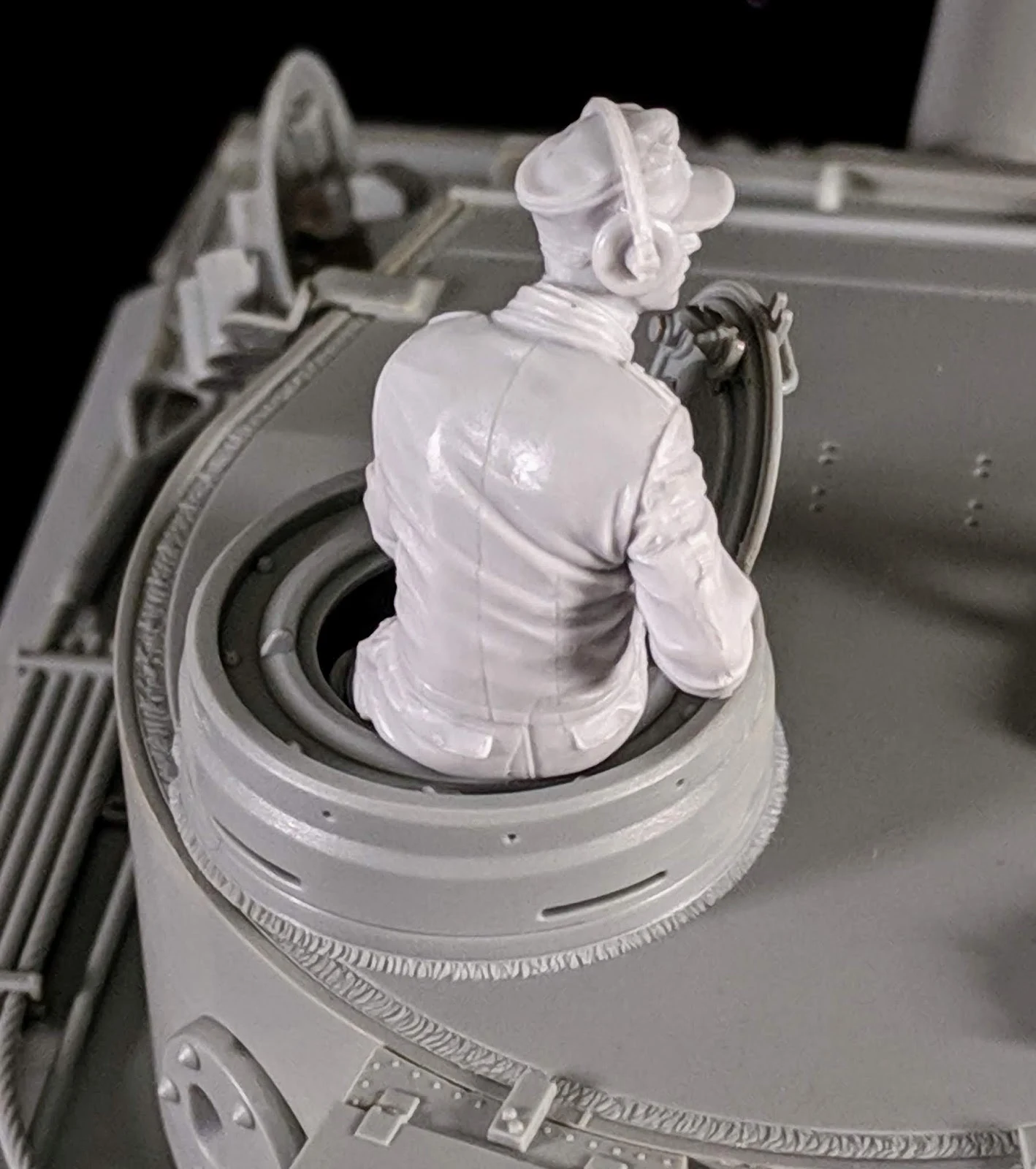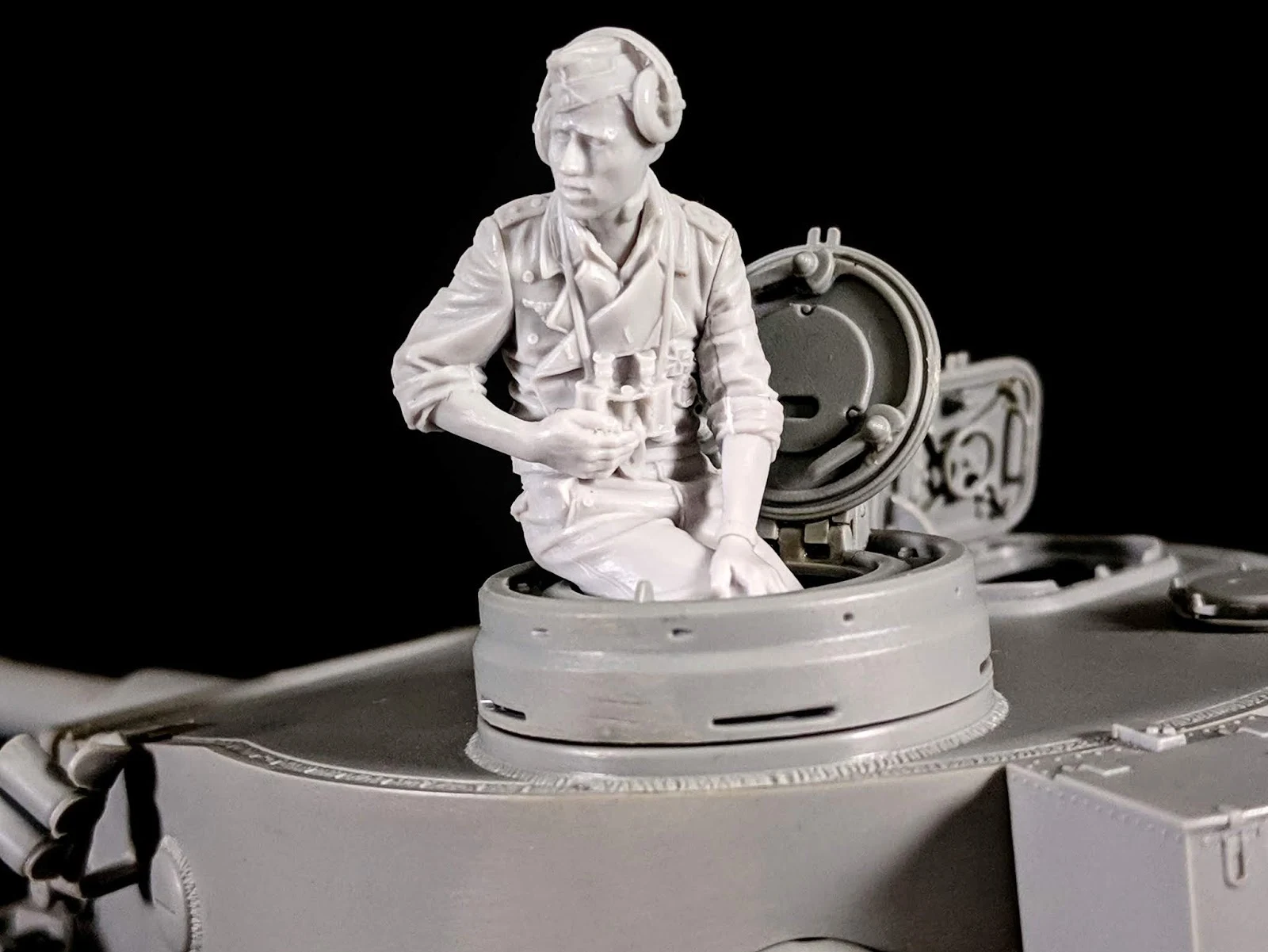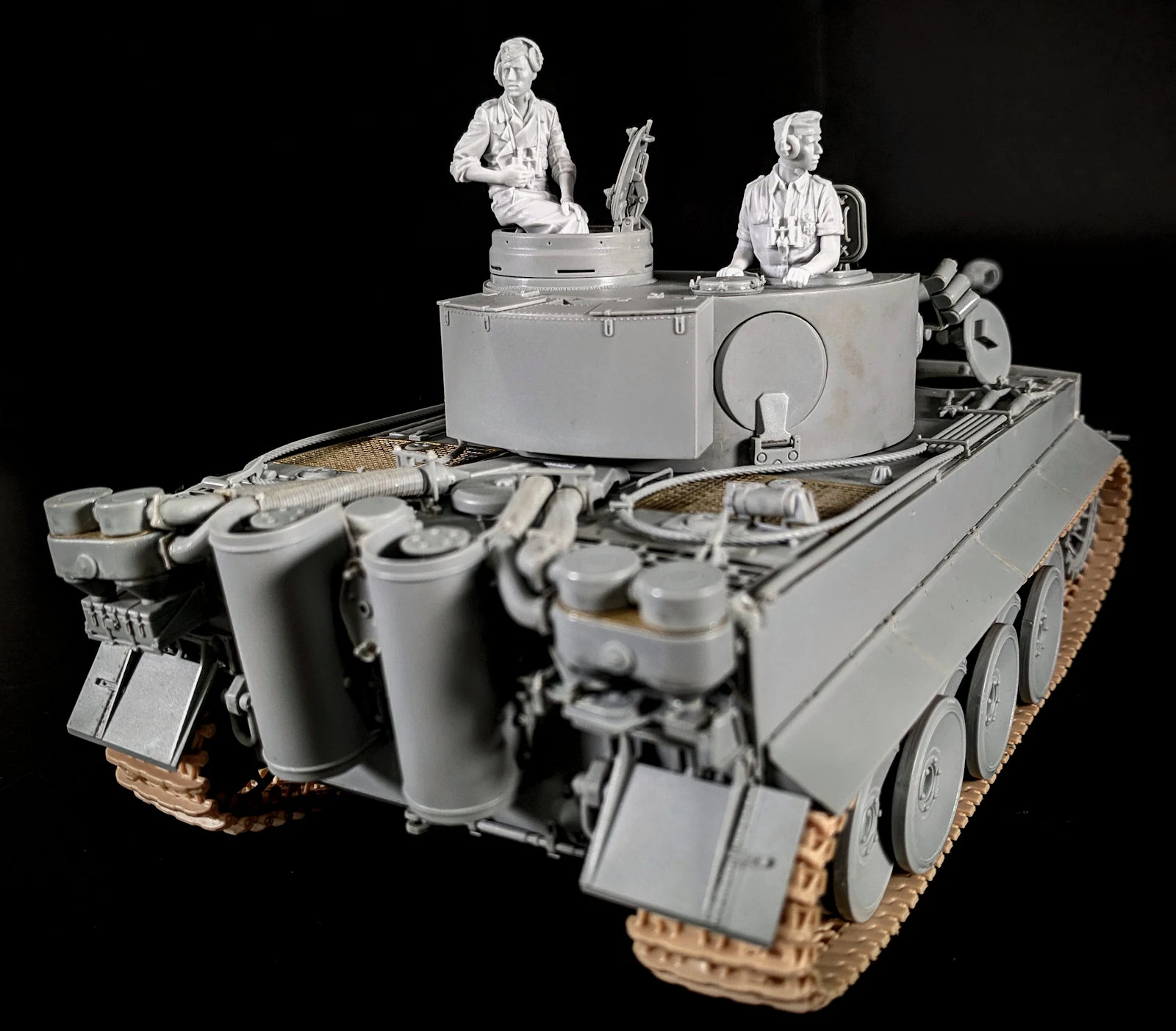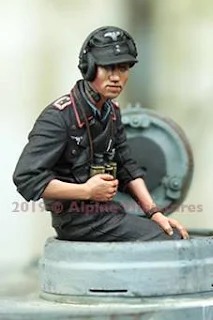
Alpine Miniatures has gone against the grain of making their perceived niche of late WWII Winter German Tanker crews with a pair of summer crew instead. Seriously these are two very nice looking figures are full-bodied and in 35th scale ready to drop into your latest German tank kit. Are they any good? We put them together in our review to show you...

Construction Review:
German Panzer Commander Summer #1
# 35263
1/35th scale
Sculpture by Taesung Harmms
Boxart by Dr. Jin Kim
The kit includes one figure with 2 different heads choices.

German Panzer Commander Summer #2
# 35264
1/35th scale
Sculpture by Taesung Harmms
Boxart by Dr. Jin Kim
The kit includes one figure with 2 different heads choices.

German Panzer Commander Summer Set
#35265
1/35th scale
Sculpture by Taesung Harmms
Boxart by Dr. Jin Kim
Two figures with eleven parts in light grey resin
The kit includes 2 figures with 2 different heads each.

Construction Review:
We recently received a sneak peek of Alpine Miniatures new figures to suit any World War II tank. These two figures in Summer uniforms are both commanders or at least highly decorated tank, soldiers. They are both full body figures, often we see manufacturers offering half body figures that are starting to look out of place in the new full interior tanks that people are finding new ways to display the insides of the vehicles.
I thought the best way to show these figures is to illustrate what is in each of the figure's bags, then make them up individually showing them with both head choices so you can see if you like them. So without further ado...
Construction Review: German Panzer Commander Summer #1
# 35263
1/35th scale
Sculpture by Taesung Harmms
Boxart by Dr. Jin Kim
The pictures show the figure with 2 different heads choices.
This first figure, called simply "German Panzer Commander Summer #1" is sold singularly or in the set of two commanders. The sculptor, Taesung Harmms has created a tank commander from WWII in a mid-late version uniform of summer weight. You could well use him as an early war tanker also, but to me, he looks more mid-late war in his attire. He is cast in six parts in light grey resin - this stuff doesn't smell, and there were no surface bubbles that I can see. He is also, packed with sculpted detail I will talk about now.
The No #1 commander has the choice of two headgears with this figure, either the M43 peaked cap or the Overseas M38 forage cap. I thought we would look at both of the head choices in isolation. The faces on both head choices are the same face, they are finely sculpted and details like lines in the face, hair, ears, nose and lips are really well sculpted. Each of these head choices has the RT "cans" over the figure's head - a separated gap between it and the hats that it pushes down on and squashes realistically in the sculpt.
You can see the flat overseas M38 forage cap the tankers often wore, & on this one the details that picked out a tanker's cap, the black colour, the national emblem eagle in silver braid, and the real identifier of the Panzer Korps, the Waffenfarbe Rosa (pink) colour with pink being chosen for Panzer crews.
The M38 cap on the soldier on the right below
Here you can see a closer picture of the German eagle and swastika and the circular cockade which is replicated on the M38 hat
The second headgear choice is the mid-latter war style M43 field cap (Einheitsmütze) used by the German Wehrmacht and SS, during World War II. A similar design of the field cap was previously used in Germany as the distinguishing headgear of the German Gebirgsjäger's ski cap, the only differences being the bill was slightly extended and the top panel of the hat had a smaller circumference, giving it slightly sloped-in sides.
On his chest on the left-hand side he wears three medals - In order from left to right: German WWII Tank Assault Badge (Wehrmacht Panzerkampfabzeichen) - awarded to troops in armoured divisions, usually with numbers in increments at the bottom to show enemy vehicles destroyed. Iron Cross (Eisernes Kreuz) Awarded for bravery before the enemy or excellence in commanding troops. The Wound Badge (Verwundetenabzeichen) was a military decoration awarded to members in the Reichswehr, the Wehrmacht, SS and the auxiliary service organizations during the Second World War. It was awarded when the wound was the result of enemy hostile action, with an exception being for frostbite.
On the uniform blouse the soldier is wearing you can see the rolled-up sleeves, the collar that wrinkles where it sits on the shoulder blades of the soldier, the shirt pinching as it is tucked into the belt of the soldier also. The shirts were most commonly worn without insignia although shirts with breast eagles, sleeve rank and shoulder straps/boards are not uncommon (here we have shoulder boards on the shirt).

The Officers and certain senior NCO’s could choose to purchase their uniform items from the armed forces clothing depots or to privately purchase garments of higher quality. Although enlisted personnel were issued their uniforms from government supplies they were also permitted to purchase privately tailored uniform items.
The field glasses on this soldier's chest are the shorter style 6x30 type. The German Wehrmacht used a wide variety of optical enhancement items with the 6 x 30 power, (6 power magnification with a 30mm diameter objective lens), binoculars being the standard-issue optics utilized by personnel serving in all branches of military service. When issued, the binoculars came with a variety of assorted accessories which included neck-straps, buttoning flaps, designed to secure the binoculars to a uniform button protective lens covers and specific protective carrying/storage cases.
Heer issue binoculars were originally produced with a black finish which was generally altered to ordnance tan, presumably in late 1941 or early 1942 along with some other pieces of equipment.

You can see in these pictures of the rear of the commander his baggy shirt at the waist - pinched by his belt along with the almost flat front of the trousers at the front, in contrast with the slightly wrinkled texture at the back denoting his body language of looking slightly behind him and the natural tendency of these pants to wrinkle where one bends the knees - very observant from the sculptor.
An example of a few panzertruppen wearing this simple field blouse

The Officers and certain senior NCO’s could choose to purchase their uniform items from the armed forces clothing depots or to privately purchase garments of higher quality. Although enlisted personnel were issued their uniforms from government supplies they were also permitted to purchase privately tailored uniform items.
The field glasses on this soldier's chest are the shorter style 6x30 type. The German Wehrmacht used a wide variety of optical enhancement items with the 6 x 30 power, (6 power magnification with a 30mm diameter objective lens), binoculars being the standard-issue optics utilized by personnel serving in all branches of military service. When issued, the binoculars came with a variety of assorted accessories which included neck-straps, buttoning flaps, designed to secure the binoculars to a uniform button protective lens covers and specific protective carrying/storage cases.
Heer issue binoculars were originally produced with a black finish which was generally altered to ordnance tan, presumably in late 1941 or early 1942 along with some other pieces of equipment.


The two arms and the P38 pistol holster are provided separately. If you notice on the pistol holster the notch to fit to the socket sculpted into it for correct placement. also on each arm are the small nibs to fit into each bicep joint. The soldier's fingers and watch are easy details to pick out in this sculpt which are things many other sculptors do not do so well.


Putting him together:
This figure only took about ten minutes tops to clean off the moulding tabs that come along with it and put the parts on to the figure. Smart engineering helps here and Alpine often make it easier to locate the proper fit for the figure to be displayed correctly and give him the body language the sculptor intended. Sockets and joints of the figure are all made to ease construction times. The arms and the pistol in the holster all have a socket to fit into a natural join. This allows them to be fitted and painted without penalty later in the build if that is your preference.
The neck joint needs to be carved off the casting block in the correct angle so the neck socket fits perfectly for him to look on the side.
A close up of his holster, the arms and the midsection of the figure in nice detail.
 OK, so now he is all together I thought I would give you a walk around of each completed figure, First, we will look at the variant with the overseas cap.
OK, so now he is all together I thought I would give you a walk around of each completed figure, First, we will look at the variant with the overseas cap.
Like the real thing, the trousers have tapered cuffs with drawstrings and tapes that can be tied in order to fit into or over lace-up ankle boots. as we can see below - even the shoelaces are included in this sculpt!



...And inside the cupola of the tiger I (as in the boxart. - this figure's hands fit neatly on the turret ring of the Tiger when you position them just right.
The second headgear choice is next - with the peaked M43 hat on this tank commander...
Again, inside the Tiger I Coppola, he fits in nicely.
From below - at a soldier's eye vantage point I like the look of the body language on this soldier.
Construction Review: German Panzer Commander Summer #2
# 35264
1/35th scale
Sculpture by Taesung Harmms
Boxart by Dr. Jin Kim
The pictures show the figure with 2 different heads choices.
This figure is again sculpted by Taesung Harmms, and he comes cast in five parts in light grey resin. The resin is again bubble-free on the surface, and although there is a slight seam on the rear of the soldier this isn't a big obstacle to remove. The parts are attached to casting points or blocks that are in easy to remove places also. At first glance he is lavished with just as much attention to detail as his comrade commander, the wrinkly Panzer wrap jacket and pants over his issue tunic, the twisting body language pulling the clothing to one side, the extra details like his opticals on his chest with straps moulded in, the headphones and throat mic, the decorative medals on his chest all adding to the base figure which is impressive in it's own right.
There are two head choices again with this offering - that of the M43 peaked cap and the overseas M38 cap. The two head choices below - with the same facial features, nose, eyes, ears, mouth and hair finely sculpted.
The peaked cap is the popular M43 field cap (Einheitsmütze), again similar detail of the German eagle with the two buttons holding the side flaps up is here on the figure. Below as an example, we see a panzer commander in 1943 (albeit in a colder Kharkov) with the headphones over his M43 hat.
The M38 overseas cap was based on the previous pattern M34 overseas cap as worn by EM/NCO’s. Originally the M38 was only produced in field-grey until March 27TH 1940 when a black panzer version for Panzer officers was introduced. The national eagle was applied to all field caps as well as a circular cockade in black, white, and red and was utilized throughout the Third Reich period. The different branches of service within the army were allocated a specific, identifying, waffenfarbe colour with pink (Waffenfarbe Rosa) being chosen for Panzer, (Armored) personnel.
The M38 from a museum collection


Both of the headgear on these figures is shown by these two commanders on the same tank (who said that wouldn't ever happen?)


This figure's communication device on both heads is the Panzer Headset & Throat Microphone. These headband & rubber cupped ear pieces Dfh.b model headphones and throat mic (Dfh.b - Doppelfernhörer, (Double Telephone Receiver) were normally found in use in Panzers and other tracked and AFV's of the German Reich. They are well represented and notable inclusions here.

These cans sit prominently on top of and push down the servicemen's caps they are wearing. The throat mic's are also pinched slightly at the neck just above this figure's collar...

You can see the tanker is in the typical WWII black Panzerjacke, this short jacket is pinched at the waist by his belt, this divides the body in two, and gives his waist definition while the folds and wrinkles on the arms and the tunic and the lapels opening up to reveal his summer wright issue shirt underneath.
A panzer commander in much the similar outfit somewhere in the field during WWII. Made from black wool hip-length double-breasted jacket and trousers, with skulls on the collar patches instead of Litzen and, officially until 1942, collar piping in Waffenfarbe (usually the rose-pink of the armoured branch. The colour and Totenköpfe (skulls) were chosen due to their similarity to the uniforms of August von Mackensen's Black Hussars, and also for practical reasons: the black colour made oil stains less visible and a short jacket was less likely to get caught in the machinery. Although the jacket could be buttoned to the neck in cold weather, ordinarily it was worn open-collar with a field grey or mouse grey shirt and (in theory) a black necktie.
The real double-breasted black panzer wrap tunic (Feldjacke für Panzertruppe) showing the details of the jacket a little better for comparison.

The pants of the figure are made of a similarly weighted fabric, with the wrinkles and folds adding to the body language of the sculpt showing him leaning off to the side. His short, mid-late war boots also are suitable for his timeframe and summer weight clothing. Not that you will probably see them inside the tank but the detail is sharp from head to toe on this and the companion figure also.



The arms of the figure come attached to a casting block and are an easy and not so dangerous removal with a little clean up only needed to have them ready to add to the figure. The wrinkled panzer jacket tunic sleeves are thickly rolled up at the forearm and the folds will make an impressive detail to the finished kit. Notice that the left arm joins the hand of the figure at the knee at the figure's wristwatch to ensure a perfect fit.
Fit & Engineering:
Again, and I have to say with all of Alpine's figures I have made - the parts of the figure fit together perfectly if you align them just right. This figure has a neck joint that is sloped off to one side so it fits inside the collar in a seamless join facing the correct side and angle.
The arms of the figure are joining the torso at the shoulder seams of his panzer jacket and at the wristwatch on the left arm, while the right-hand side cradles his optical glasses. These glasses are very much like his comrade's opticals.
On this picture, you can see the fit of the parts around the torso - perfect! Also, some details here like the straps of his binoculars over his collars, the twisting and folding of the cloth on the jacket and pants as he pivots to the right and his medals on his chest - the afore-mentioned Iron cross and the Panzer assault badge below it on the left, lower torso.
One last thing - notice the flat bottom of the figure? Making his bum flat like this allows him to sit not just inside the commander's cupola but also on a flat turret roof also, smart thinking Alpine.
The first headgear choice of the M43 peaked cap.
Here he is sitting int he commander's Coppola of his Tiger I (as in the box art) - he looks pretty comfortable don't ya think?
The alternate head choice with the M38 flat overseas cap is just as interesting in this figure I think
Here he is from a variety of angles inside his natural fighting habitat - the Tiger I - somewhere in summer...
Construction Review: German Panzer Commander Summer Set
#35265
1/35th scale
Sculpture by Taesung Harmms
Boxart by Dr. Jin Kim
The kit contains two figures in eleven parts of light grey resin
The pictures show the 2 figures with 2 different heads each.
These two figures could either be placed in two different tanks or in the same vehicle. Either one on a ride-along or as another lower-ranked soldier. I would use them in two different tanks myself. However, the gear they are wearing is both different in nature - but fitting the others in the climate and general timeline of the things they are wearing - both look great to us also.
A closer look at both of the commanders in the same tank - I know that this is not particularly realistic - but just so you get the idea of each one from a number of angles - each with both alternate headgear on also.
A bit further back showing the commanders both on the same vehicle.
I spent a bit of time making sure that these two figures fit the vehicle as I saw in the box art - and I can say that they were a perfect fit - from the slightly indented hollows on the arms to the fingers cradling the top of the cupola - nicely engineered and thought out.
The details on each of the figures are excellent - as I said from the head(s) to the toes, the detail is busting out to be painted, and the accuracy of the clothing and the natural state of the body language - it is just all perfect.
German tankers - you know you always need more of them, and this set is amongst the best around.
Adam Norenberg
Both of these two tank commanders are available from Alpine Miniatures distributors or from the site directly if you live in the USA
If you are in the USA, you can now purchase Alpine products directly from them with free shipping on all orders (within the USA only)
Here are both sculpts - this time painted up by the cover artist Dr Jin Kim - this shows how good these could look under a steady hand...
German Panzer Commander Summer #1
1/35th scale
Sculpture by Taesung Harmms
Boxart by Dr. Jin Kim
The kit includes one figure with 2 different heads choices.
German Panzer Commander Summer #2
# 35264
1/35th scale
Sculpture by Taesung Harmms
Boxart by Dr. Jin Kim
The kit includes one figure with 2 different heads choices.
German Panzer Commander Summer Set
#35265
1/35th scale
Sculpture by Taesung Harmms
Boxart by Dr. Jin Kim
The kit includes 2 figures with 2 different heads each.












.JPG&container=blogger&gadget=a&rewriteMime=image%2F*)
























































































